Related Research Articles

Arlington National Cemetery is one of two cemeteries in the United States National Cemetery System that are maintained by the United States Army. Nearly 400,000 people are buried in its 639 acres in Arlington, Virginia.
The following is a tabulation of United States military casualties of war.
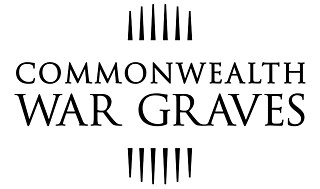
The Commonwealth War Graves Commission (CWGC) is an intergovernmental organisation of six independent member states whose principal function is to mark, record and maintain the graves and places of commemoration of Commonwealth of Nations military service members who died in the two World Wars. The commission is also responsible for commemorating Commonwealth civilians who died as a result of enemy action during the Second World War. The commission was founded by Sir Fabian Ware and constituted through Royal Charter in 1917 as the Imperial War Graves Commission. The change to the present name took place in 1960.
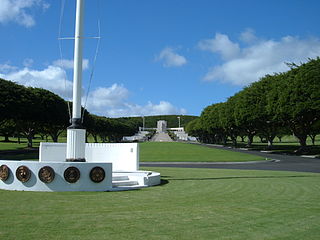
The National Memorial Cemetery of the Pacific is a national cemetery located at Punchbowl Crater in Honolulu, Hawaii. It serves as a memorial to honor those men and women who served in the United States Armed Forces, and those who have been killed in doing so. It is administered by the National Cemetery Administration of the United States Department of Veterans Affairs and is listed on the National Register of Historic Places. Millions of visitors visit the cemetery each year, and it is one of the most popular tourist attractions in Hawaii.

Missing in action (MIA) is a casualty classification assigned to combatants, military chaplains, combat medics, and prisoners of war who are reported missing during wartime or ceasefire. They may have been killed, wounded, captured, executed, or deserted. If deceased, neither their remains nor grave have been positively identified. Becoming MIA has been an occupational risk for as long as there has been warfare.

Floyd James "Jim" Thompson was a United States Army colonel. He was one of the longest-held American prisoners of war, spending nearly nine years in captivity in the forests and mountains of South Vietnam, Laos, and North Vietnam during the Vietnam War.

The Normandy American Cemetery and Memorial is a World War II cemetery and memorial in Colleville-sur-Mer, Normandy, France, that honors American troops who died in Europe during World War II. It is located on the site of the former temporary battlefield cemetery of Saint Laurent, covers 172.5 acres and contains 9,388 burials.
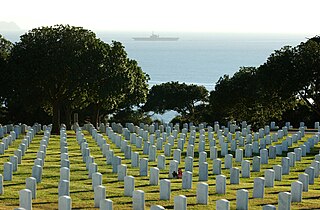
Fort Rosecrans National Cemetery is a federal military cemetery in the city of San Diego, California. It is located on the grounds of the former Army coastal artillery station Fort Rosecrans and is administered by the United States Department of Veterans Affairs. The cemetery is located approximately 10 miles (16 km) west of Downtown San Diego, overlooking San Diego Bay and the city from one side, and the Pacific Ocean on the other. Fort Rosecrans is named after William Starke Rosecrans, a Union general in the American Civil War. The cemetery was registered as California Historical Landmark #55 on December 6, 1932. The cemetery is spread out over 77.5 acres (31.4 ha) located on both sides of Catalina Blvd.
The Defense Prisoner of War/Missing Personnel Office (DPMO), as part of the United States Department of Defense, was an organization that reported to the Under Secretary of Defense for Policy through the Assistant Secretary of Defense. DPMO provided centralized management of prisoner of war/missing personnel (POW/MP) affairs within the Department of Defense.
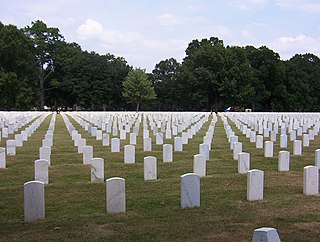
Memphis National Cemetery is a United States National Cemetery located in the Nutbush neighborhood in northeast Memphis, Tennessee. Administered by the United States Department of Veterans Affairs, it encompasses 44.2 acres (17.9 ha), and as of the end of 2007, had 42,184 interments.

The Joint POW/MIA Accounting Command was a joint task force within the United States Department of Defense (DoD) whose mission was to account for Americans who are listed as Prisoners of War (POW), or Missing in Action (MIA), from all past wars and conflicts. It was especially visible in conjunction with the Vietnam War POW/MIA issue. The mission of the Joint POW/MIA Accounting Command was to achieve the fullest possible accounting of all Americans missing as a result of the nation's past conflicts. The motto of JPAC was "Until they are home".
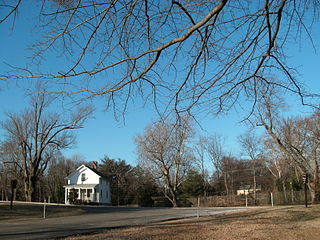
Fort Hunt Park is a public park located in Fort Hunt, Fairfax County, Virginia. It is administered by the National Park Service as part of the George Washington Memorial Parkway. The park preserves the remains of the eponymous Fort Hunt, portions of which date to the time of the Spanish–American War. The park was named after Brigadier General Henry Hunt, who served as chief of artillery of the Army of the Potomac during the Civil War. Remains of several of the fort's original batteries, including Battery Mount Vernon, Battery Robinson, and Battery Sater, and Battery Porter, have been preserved, and may still be visited today. The structures have been stabilized enough that visitors are able to climb on them without difficulty. Besides the batteries, the battery commander's station still stands; in addition, a flagpole has been erected as a memorial to the intelligence officers who served at the fort during World War II.

Mortuary Affairs is a service within the United States Army Quartermaster Corps tasked with the recovery, identification, transportation, and preparation for burial of deceased American and American-allied military personnel. The human remains of enemy or non-friendly persons, are collected and returned to their respective governments or affiliations.

Blue Beach Military Cemetery at San Carlos is a British war cemetery in the Falkland Islands holding the remains of 14 of the 255 British casualties killed during the Falklands War in 1982, and one other killed in early 1984. It is situated close to where 3 Commando Brigade had its initial headquarters after landing on 21 May 1982.

Clark Veterans Cemetery is located in Clark Freeport Zone, Angeles City, Philippines. The cemetery is the burial place for thousands of mainly American veterans and Filipino Scouts who served in the United States Army, and who died in conflicts other than World War II or on military bases in the Philippines.

The United Nations Memorial Cemetery in Korea, located at Tanggok in the Nam District, City of Busan, Republic of Korea, is a burial ground for United Nations Command (UNC) casualties of the Korean War. It contains 2,300 graves and is the only United Nations cemetery in the world. Laid out over 14 hectares, the graves are set out in 22 sites designated by the nationalities of the buried servicemembers.

Cemetery for North Korean and Chinese Soldiers located in Jajang-Ro, Papyeong-myeon (파평면), Paju, South Korea, is a burial ground for North Korean casualties of the Korean War and North Korean agents killed in South Korea since the end of the war. The cemetery formerly contained the remains of 437 Chinese People's Volunteer Army soldiers but these were all repatriated in March 2014.
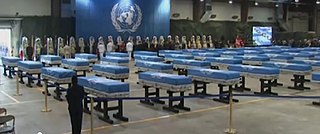
The recovery of US human remains from the Korean War has continued since the end of the war.
Thomas James Eugene Crotty was a United States Coast Guard lieutenant. He was the first Coast Guardsman to become a prisoner of war since the War of 1812 and the only Coast Guardsman to be captured during World War II and since.
References
- ↑ Coleman, Bradley Lynn (January 2008). "Recovering the Korean War Dead, 1950–1958: Graves Registration, Forensic Anthropology, and Wartime Memorialization". The Journal of Military History . Project Muse (Society for Military History). 72 (1): 179–222. doi:10.1353/jmh.2008.0013. ISSN 0899-3718. S2CID 162230190. Archived from the original on 2020-04-01. Retrieved 2013-11-11.
- ↑ "Operation GLORY: Historical Summary". Condensed from Graves Registration Division, Korean Communications Zone (KCOMZ). Fort Lee, VA: Army Quartermaster Museum. July–December 2004. Archived from the original on 2007-12-28. Retrieved 2013-11-11. Note: the calculation of remains comes from Coleman as the "Historical Summary" gives a total of 4,023 UN remains received.
- ↑ But see: Sherrell, Chandler (1998). A Historical Analysis of United States Prisoner of War/Missing in Action Repatriation and Remains Recovery. Fort Leavenworth, Kansas: U. S. Army Command and General Staff College. p. 38. OCLC 831669354. Archived from the original on 2016-03-04. Retrieved 2013-11-12.
During Operation GLORY, 1,879 sets of remains were returned. Of those, 1,020 were positively identified, and another 859 unidentified remains were declared unknown casualties.
- ↑ Not all remains were returned to the home countries. Some of the 2,300 remains buried at the United Nations Memorial Cemetery in Busan, South Korea were recovered during Operation Glory.
- ↑ Keene, Judith (February 2010). "Below Ground: The Treatment of American Remains from the Korean War". The Public Historian . National Council on Public History. 32 (1): 58–78. doi:10.1525/tph.2010.32.1.59. ISSN 0272-3433. JSTOR 10.1525/tph.2010.32.1.59. PMID 20503915.
- 1 2 Sledge, Michael (2007) [2005]. Soldier Dead: How We Recover, Identify, Bury, and Honor Our Military Fallen. New York: Columbia University Press. pp. 78, 199. ISBN 9780231509374. OCLC 60527603.
- ↑ Cole, Paul M. (1994). "Three: Efforts to Recover and Account for Korean War Casualties". POW/MIA Issues Volume 1, The Korean War (PDF). Santa Monica, CA: National Defense Research Institute. p. 68. ISBN 9780833014825. OCLC 855303293. Archived (PDF) from the original on 2013-11-12. Retrieved 2013-11-12.
